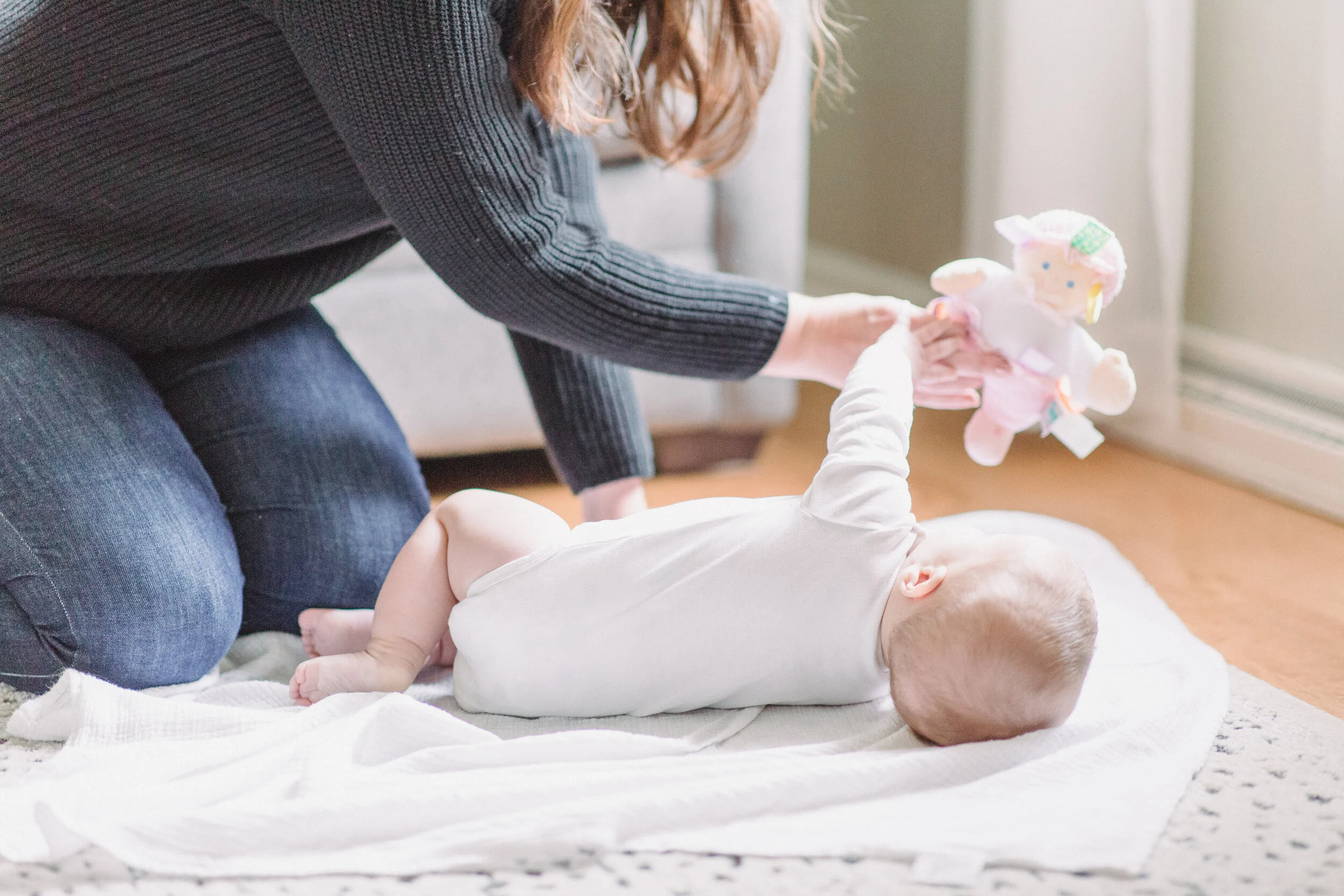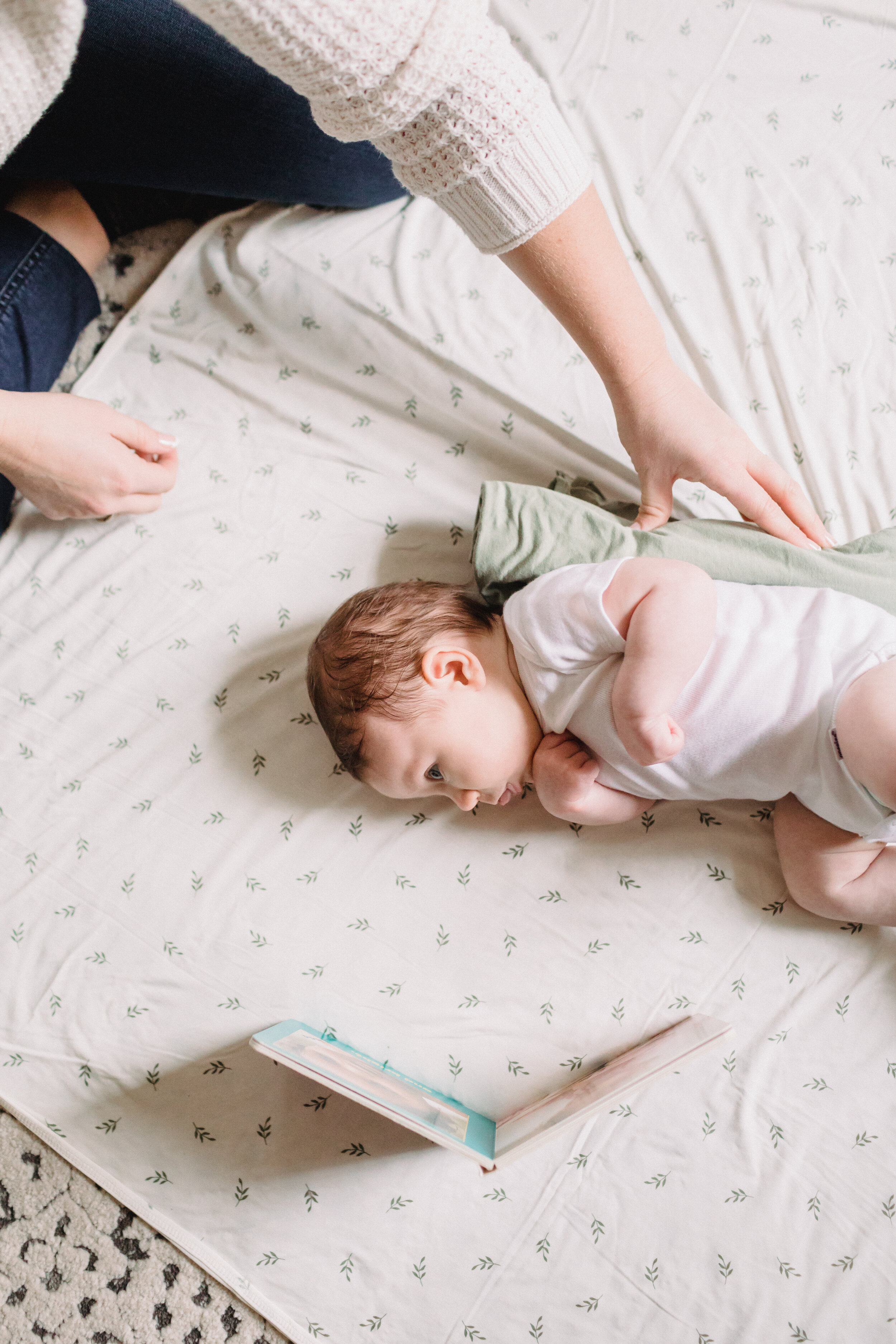Why rolling is important
Rolling is one of baby’s first forms of mobility. It allows baby to start the process of seeing something and actually going to get and explore it. Rolling is a complicated movement that requires the two sides of the body to do opposite movements. This is important for the brain- body connection (i.e., how the body learns to respond appropriately when the brain says “reach”), to build neuronal maps (i.e., how baby will learn to move in 3D space), to strengthen bilateral coordination skills (i.e., to use both sides of the body), and is preparing baby to develop more complex movements.
Rolling is one of the first transitional movements a baby completes. It is a building block for more complicated movements to come, like sitting, reaching and crawling. It is how baby begins to move from his/her belly to back (~3-4 months old) and back to belly (~5 months old). It leads to consecutive rolling so baby can log roll across the room to get to a toy. Rolling also primes the body’s nervous, muscular, and sensory systems for the more complex movements to come.
How long and how often?
Rolling can easily be incorporated into your tummy time play. At 2+ months of age, aim to play on the floor for at least 90 minutes a day (total). This includes your tummy time play. Encourage baby to move toward toys or people in the room while you’re playing on the floor. Rolling will come as baby becomes motivated to get to interesting people and things.
If your baby is fussing on the floor in tummy time, help him/her roll over. Baby is often fussing due to being stuck and frustrated. By responding to baby’s communication cue of fussing and helping him/her roll gently from tummy to side or back you are reinforcing to baby that when he/she calls for you, you respond. When your baby has calmed, gently help roll him/her back onto the tummy for another few minutes of tummy time. Repeat this with rolling evenly to both sides until you see your baby needs a break (e.g., fussing without easily calming, clenching hands, arching back, etc.)
Help baby roll to the right by moving the right arm into a more extended “give a high 5” position, with arm extended but in front of the body, then help him/her slowly through a roll. You don’t want to simply flip baby over and flop onto his/her back. Slow movement is key because it causes baby’s muscles to kick in and help with the motion. Baby is working most when half way through the position, on his/her side. If your baby will stay on a side and play a while, engage him/her there with a book or make silly faces. Be mindful to always work on rolling the same number of times left and right.
What baby is working toward:
Continuous rolling across the floor to get to a person or object
Using two sides of the body in a complementary way to complete a task
Reaching and playing with toys with both hands on tummy, back and in supported sitting
Precursor skills for crawling and walking
Use our milestone checklists to track your child’s skills and progress and always speak with your pediatrician if you are concerned about your child’s motor development. There are delays and disorders that are unavoidable and require early detection and prompt intervention by a licensed Occupational or Physical Therapist.
Top 3 positions for rolling for a baby 2-5 months
1. Sidelying: Place baby on his/her side with a towel or blanket rolled up behind the back. Place a toy, book or something interesting in front of and a little above baby’s eye level to encourage him/her to roll by reaching and moving toward the item.
2. Strategic toy placement: Place baby on his/her tummy with a preferred toy off to one side, above eye level (so they don’t roll onto it) and just out of reach so they have to move to get to it. Encourage baby to move toward the toy by shaking it or putting your face near it. You can help baby by placing the palm of your hand on his/her bottom and gently rocking his/her hips toward one side. This will help baby shift his/her weight and begin a roll to the side you shifted them toward.
3. Blanket: Use a blanket to assist with the roll. Place baby in the middle of a blanket on a bed or padded/carpeted floor. You sit on one side of the blanket. Roll the blanket up in your hands so there are only 2-3 inches between your hands and baby. Place a toy on the blanket away from you, as baby reaches for the toy, lift the blanket into the air (no more than an inch) to assist baby to roll away from you and toward the toy.
Rolling is an important motor skill to begin independent movement. It’s the first one your baby is likely to accomplish that will help build a strong foundation for more movement to come. Help motivate your baby to roll toward you or toward interesting toys by being strategic about your toy placement when he/she is on the floor.
Bree
We’re Bree & Jaclyn
Pediatric therapists and moms with a mission to empower you with knowledge to encourage your baby’s development and continue confidently into your parenthood journey.
If you have any questions, please feel free to leave a comment below and we will get back to you. As always, the information we share is meant to provide general education and tips and is not intended as medical advice. If you have a specific question or concern about your child’s development, please speak directly to your child’s doctor or therapist.






